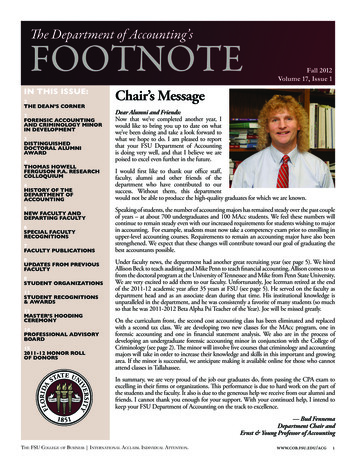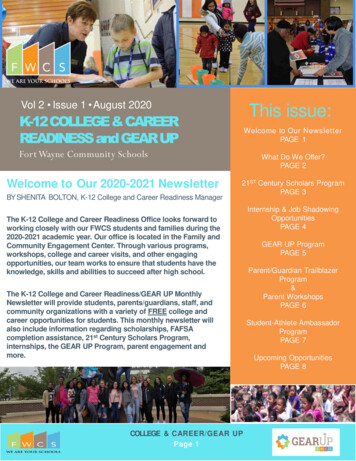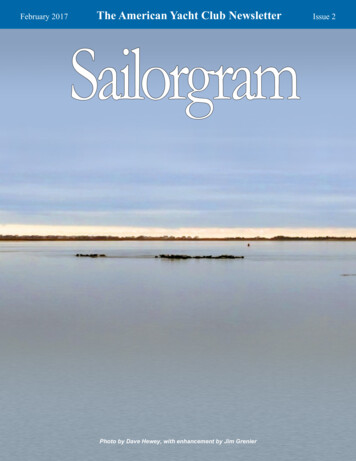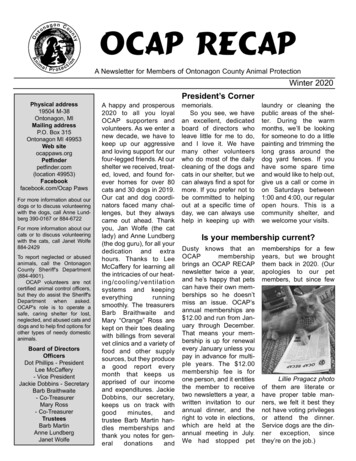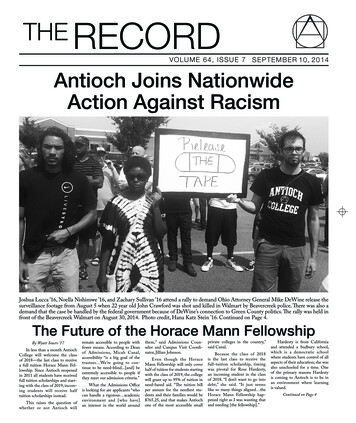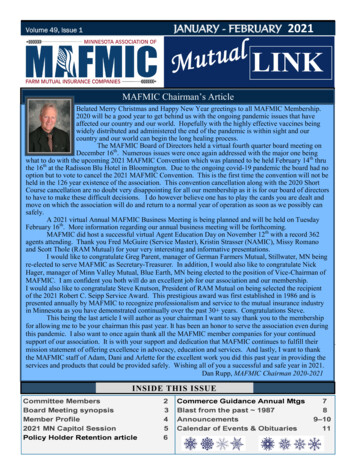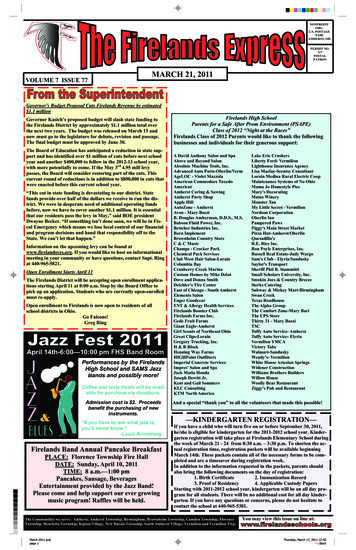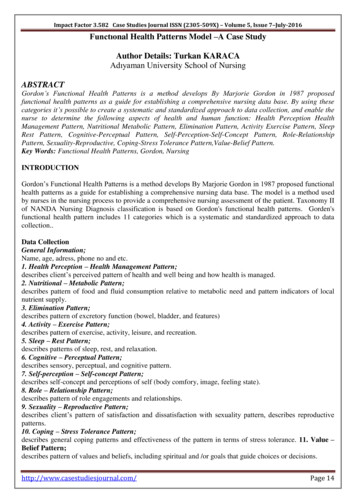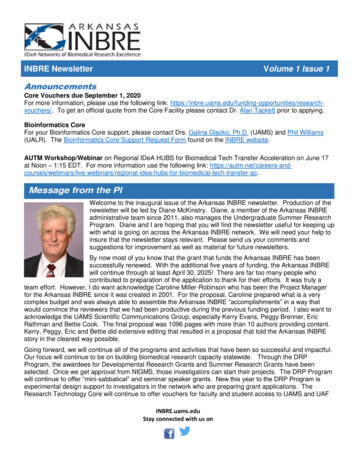
Transcription
INBRE NewsletterVolume 1 Issue 1AnnouncementsCore Vouchers due September 1, 2020For more information, please use the following link: rchvouchers/. To get an official quote from the Core Facility please contact Dr. Alan Tackett prior to applying.Bioinformatics CoreFor your Bioinformatics Core support, please contact Drs. Galina Glazko, Ph.D. (UAMS) and Phil Williams(UALR). The Bioinformatics Core Support Request Form found on the INBRE website.AUTM Workshop/Webinar on Regional IDeA HUBS for Biomedical Tech Transfer Acceleration on June 17at Noon – 1:15 EDT. For more information use the following link: ansfer-ac.Message from the PIWelcome to the inaugural issue of the Arkansas INBRE newsletter. Production of thenewsletter will be led by Diane McKinstry. Diane, a member of the Arkansas INBREadministrative team since 2011, also manages the Undergraduate Summer ResearchProgram. Diane and I are hoping that you will find the newsletter useful for keeping upwith what is going on across the Arkansas INBRE network. We will need your help toinsure that the newsletter stays relevant. Please send us your comments andsuggestions for improvement as well as material for future newsletters.By now most of you know that the grant that funds the Arkansas INBRE has beensuccessfully renewed. With the additional five years of funding, the Arkansas INBREwill continue through at least April 30, 2025! There are far too many people whocontributed to preparation of the application to thank for their efforts. It was truly ateam effort. However, I do want acknowledge Caroline Miller-Robinson who has been the Project Managerfor the Arkansas INBRE since it was created in 2001. For the proposal, Caroline prepared what is a verycomplex budget and was always able to assemble the Arkansas INBRE “accomplishments” in a way thatwould convince the reviewers that we had been productive during the previous funding period. I also want toacknowledge the UAMS Scientific Communications Group, especially Kerry Evans, Peggy Brenner, EricRathman and Bettie Cook. The final proposal was 1096 pages with more than 10 authors providing content.Kerry, Peggy, Eric and Bettie did extensive editing that resulted in a proposal that told the Arkansas INBREstory in the clearest way possible.Going forward, we will continue all of the programs and activities that have been so successful and impactful.Our focus will continue to be on building biomedical research capacity statewide. Through the DRPProgram, the awardees for Developmental Research Grants and Summer Research Grants have beenselected. Once we get approval from NIGMS, those investigators can start their projects. The DRP Programwill continue to offer “mini-sabbatical” and seminar speaker grants. New this year to the DRP Program isexperimental design support to investigators in the network who are preparing grant applications. TheResearch Technology Core will continue to offer vouchers for faculty and student access to UAMS and UAFINBRE.uams.eduStay connected with us on
core facilities. The joint UALR-UAMS bioinformatics graduate program continues as part of the BioinformaticsCore. In addition, Bioinformatics Core personnel will continue to support Arkansas INBRE investigatorswhose research involves “big data”. Finally, the Outreach Core will continue with Undergraduate SummerResearch Program and the Arkansas INBRE Research Symposium held annually in Fayetteville.Thanks for your continued support. I look forward to working with all of you over the next five years to growbiomedical research capacity in Arkansas.Faculty SpotlightJosh Sakon, PhDUniversity of Arkansas at FayettevilleDr. Josh Sakon is a professor in the Department of Chemistry and Biochemistry at theUniversity of Arkansas. His laboratory uses X-ray diffraction to study the biochemistry oflarge molecules at the atomic level. Recently, Dr. Sakon was one of seven awardrecipients through the NIH-funded XLerator Network’s Ideas-to-Products (I2P) Program.Link to the announcement: https://xleratornetwork.com/i2p/. Dr. Sakon is working on anovel, lesion-seeking biologic that has the potential to improve cardiac function afterstent placement to treat coronary blockages and minimize the risk of subsequent heartfailure. Dr. Sakon and his collaborators will develop and test a novel human fibroblastgrowth factor fused to a collagen binding domain that will be released through a stent.The approach improves current methods of controlled release as it takes advantage ofspecific biochemical events that occur during adverse ventricular remodeling. Safety and feasibilityassessments will be conducted with the long-term goal beingWhat you might not know aboutdevelopment of a therapeutic that can be used to promoteDr. Sakon regeneration of heart muscle following damage due to amyocardial infarction or heart attack.Finished 84th in 2001 BostonMarathon (2:36:20)Dr. Sakon joined the University of Arkansas faculty in 1997. He isone of Arkansas BRIN/INBRE “pioneers”. His involvement in theA gourmet chef who teaches aArkansas INBRE began in 2001 when the Arkansas BRIN waspopular UARK course “Molecularfirst funded through a grant from the NIH National Center forGastronomy” featuring modernistResearch Resources. Dr. Sakon co-directs the Biotechnologyand traditional techniquesCore and in that role helps Arkansas INBRE network faculty andstudents access University of Arkansas core facilities.Development Research Project ProgramJerry Ware, PhD, Program DirectorMoving forward with a new 5-year renewal of the Arkansas INBRE, I want to update youon The Developmental Research Project (DRP) Program. Indeed, the DRP Program is acornerstone of the Arkansas INBRE to expand and support sustainable biomedicalresearch among the Primarily Undergraduate Institutions (PUIs) in Arkansas. Insuringyou are on the Arkansas INBRE email list we’ll keep you up-to-date of the variousFunding Opportunity Announcements (FOAs) as they are announced. The DRP Programsupports a wide-range of opportunities throughout the year, including seminar support,mini-sabbatical support, equipment purchase, faculty recruitment, and support of PUIfaculty research in their laboratories. Details on each of these funding opportunities canbe found on the Arkansas INBRE website or you can always direct questions to me (jware@uams.edu) or Dr.Tom Kelly (KellyThomasJ@uams.edu).INBRE.uams.eduStay connected with us on
Upcoming FOAs for the summer will include a new funding mechanism, Collaborative Research Grants, andEquipment Purchase Grants. These FOAs will be available by mid-June. Faculty wishing to apply forResearch opportunities are strongly encouraged to attend an INBRE-sponsored Grant Writing Workshop.These workshops are typically presented 6-8 weeks prior to a proposal deadline and provide guidance and tipsfor a successful application based on the NIH format of proposals. A tentative workshop is being planned forJune 26th via a 3-4 hour Zoom presentation led by the Arkansas INBRE Leadership and scientific writers fromthe UAMS Science Communication Group. Registration details will be coming soon.In anticipation of receiving our competitive renewal, FOAs were released in 2019 for our ResearchDevelopment Grants (RDG) and the 2020 Summer Research Grants (SRGs). We were pleased to receivetwenty-five applications from nine PUIs in response to the RDG FOA and sixteen applications from eight PUIsin response to the SRG FOA. The quality of the proposals was outstanding and it is a credit to the excellentwork being done among all the PUI faculty. We were able to support nine RDG applications and seven SRGproposals representing ten different PUIs in the state. The funded projects are listed below and we lookforward in future newsletters to highlight the accomplishments of each Project Leader.Research Development GrantsDavid Donley, Harding UniversityEvaluating how free radicals shape microglia during neurological diseaseVictoria Dunlap, University of Central ArkansasEffects of environment and neurodegenerative proteins on PEP-10 and calmodulinBill Gunderson, Hendrix CollegeSpectroscopic characterization of the iron-sulfur repair enzyme, YtfEZeeshan Habeeb, University of Arkansas at Pine BluffImproving bioavailability and active targeting of cisplatin by peptidic foldamersSharon Hamilton, Ouachita Baptist UniversityIncorporating proteins in novel modern wound dressingArijit Mukherjee, University of Central ArkansasUsing molecular genetic approaches to study plant-microbe symbiosisRodney Roosevelt, Arkansas Tech UniversityTesting the noradrenergic hypothesis of transcutaneous vagus nerve stimulationShanzhi Wang, University of Arkansas at Little RockProtein production and inhibitors of extracellular proteases of S. aureusJianfeng (Jay) Xu, Arkansas State UniversityOral delivery of a plant cell-encapsulated biopharmaceutical for treatment of inflammatory bowel disease2020 Summer Research GrantsMohammad Alam, Arkansas State UniversityTrifluromethyl substituted pyrazole derivatives as antibacterial agentsMarline Bossus, Lyon CollegeMechanisms of osmoregulation in Ambystoma mexicanumTamara Haselkorn, University of Central ArkansasBacterial symbionts of social amoebas and their effect on microbiome formationRajput Mrigendra, Arkansas Tech UniversityEffect of early life stress induced virome on neonatal gut healthRuth Plymale, Ouachita Baptist UniversityCharacterization of antimicrobial bacteria effective against ESKAPE pathogensJeffrey Shaver, University of Arkansas at Fort SmithInfluence of membrane desaturation and biotic stress on chloroplast DNA integrityNoureen Siraj, University of Arkansas at Little RockUnderstanding the cytotoxicity of tunable chemo-PTT ionic nanomaterialsINBRE.uams.eduStay connected with us on
2020 INBRE-Sponsored Faculty RecruitmentsArkansas Tech University / Arkansas State University / University of Central ArkansasStudent SpotlightLisa Orr2012 Former INBRE StudentLisa Orr is a graduate from the University of Arkansas at Little Rock where shereceived a Bachelor of Science degree in Chemistry. Her goal after receiving herdegree was to attend graduate school and earn a PhD. Lisa participated in theINBRE program during the summer of 2012 at the University of Arkansas forMedical Sciences in the laboratory of Dr. Alan Tackett. Her summer experiencereaffirmed her decision to go to graduate school. During the summer of 2012, Lisawas given an opportunity to focus on her own research project, “Deciphering the breast cancer histonecode”. She gave an oral presentation of her work and findings at the Undergraduate Research Symposium inBiomedical Sciences in Little Rock, Arkansas.Unfortunately, due to unexpected circumstances and personal health issues, she was unable to pursue aneducation beyond the undergraduate level. However, her research ambitions did not end there. Lisa startedemployment at UAMS with a career in research where she is working as a Research Associate in the UAMSProteomics Core and a lab manager for Dr. Tackett. These positions give Lisa the opportunity to collaboratewith both internal and external researchers, and work on her own projects. Through these efforts, Lisa is anauthor on eight publications and has been a poster presenter at several international meetings. Since thebeginning of her employment at UAMS in May of 2014, Lisa has had three promotions! Most of her days arespent at the lab bench doing what she loves to do.Recent Publications1. Choudhury R, Quattlebaum B, Conkin C, Patel SR, Mendenhall K. Dual luminescent charge transferprobe for quantitative detection of serum albumin in aqueous samples. Spectrochim Acta A Mol BiomolSpectrosc. 2020 Jul 5;235:118305. doi: 10.1016/j.saa.2020.118305. Epub 2020 Mar 24. PubMed PMID:32259717; PubMed Central PMCID: PMC7196023.2. Demirel D, Cetinsaya B, Halic T, Kockara S, Reiners D, Ahmadi S, Arikatla S. A partition-basedoptimization model and its performance benchmark for Generative Anatomy Modeling Language. ComputBiol Med. 2020 Apr;119:103695. doi: 10.1016/j.compbiomed.2020.103695. Epub 2020 Mar 5. PubMedPMID: 32339127; PubMed Central PMCID: PMC7197414.3. Sustich SJ, Afrose F, Greathouse DV, Koeppe RE 2nd. Influence of interfacial tryptophan residues on anarginine-flanked transmembrane helix. Biochim Biophys Acta Biomembr. 2020 Feb 1;1862(2):183134. doi:10.1016/j.bbamem.2019.183134. Epub 2019 Nov 16. PubMed PMID: 31738898; PubMed Central PMCID:PMC6943188.4. Zhang H, Ramsey A, Xiao Y, Karki U, Xie JY, Xu J, Kelly T, Ono S, Zhou GL. Dynamic Phosphorylationand Dephosphorylation of Cyclase-Associated Protein 1 by Antagonistic Signaling through CyclinDependent Kinase 5 and cAMP Are Critical for the Protein Functions in Actin Filament Disassembly andCell Adhesion. Mol Cell Biol. 2020 Jan 30;40(4). doi: 10.1128/MCB.00282-19. Print 2020 Jan 30. PubMedPMID: 31791978; PubMed Central PMCID: PMC6996279.INBRE.uams.eduStay connected with us on
5. Kakraba S, Ayyadevara S, Penthala NR, Balasubramaniam M, Ganne A, Liu L, Alla R, Bommagani SB,Barger SW, Griffin WST, Crooks PA, Shmookler Reis RJ. A Novel Microtubule-Binding Drug Attenuatesand Reverses Protein Aggregation in Animal Models of Alzheimer's Disease. Front MolNeurosci. 2019;12:310. doi: 10.3389/fnmol.2019.00310. eCollection 2019. PubMed PMID: 31920540;PubMed Central PMCID: PMC6920216.6. Smolander J, Stupnikov A, Glazko G, Dehmer M, Emmert-Streib F. Comparing biological informationcontained in mRNA and non-coding RNAs for classification of lung cancer patients. BMC Cancer. 2019Dec 3;19(1):1176. doi: 10.1186/s12885-019-6338-1. PubMed PMID: 31796020; PubMed Central PMCID:PMC6892207.7. Zhang N, Wright T, Caraway P, Xu J. Enhanced secretion of human α1-antitrypsin expressed with a novelglycosylation module in tobacco BY-2 cell culture. Bioengineered. 2019 Dec;10(1):87-97. doi:10.1080/21655979.2019.1604037. PubMed PMID: 30957636; PubMed Central PMCID: PMC6527068.8. Lipinski K, McKay MJ, Afrose F, Martfeld AN, Koeppe RE 2nd, Greathouse DV. Influence of LipidSaturation, Hydrophobic Length and Cholesterol on Double-Arginine-Containing Helical Peptides in BilayerMembranes. Chembiochem. 2019 Nov 4;20 (21):2784-2792. doi: 10.1002/cbic.201900282. Epub 2019 Sep18. PubMed PMID: 31150136; PubMed Central PMCID: PMC6829048.9. McKay MJ, Fu R, Greathouse DV, Koeppe RE 2nd. Breaking the Backbone: Central Arginine ResiduesInduce Membrane Exit and Helix Distortions within a Dynamic Membrane Peptide. J Phys Chem B. 2019Sep 26;123 (38):8034-8047. doi: 10.1021/acs.jpcb.9b06034. Epub 2019 Sep 17. PubMed PMID:31483653; PubMed Central PMCID: PMC6765365.10. Whitt J, Duke C, Ali MA, Chambers SA, Khan MMK, Gilmore D, Alam MA. Synthesis and AntimicrobialStudies of zoic Acid and oic Acid as Potent Growth Inhibitors of Drug-Resistant Bacteria. ACS Omega. 2019Sep 3;4(10):14284-14293. doi: 10.1021/acsomega.9b01967. eCollection 2019 Sep 3. PubMed PMID:31508552; PubMed Central PMCID: PMC6733178.*Names in bold are Arkansas INBRE PUI Project Leaders and Core Directors.INBRE.uams.eduStay connected with us on
Bill Gunderson, Hendrix College Spectroscopic characterization of the iron-sulfur repair enzyme, YtfE Zeeshan Habeeb, University of Arkansas at Pine Bluff Improving bioavailability and active targeting of cisplatin by peptidic foldamers Sharon Hamilton, Ouachita Baptist Univers
